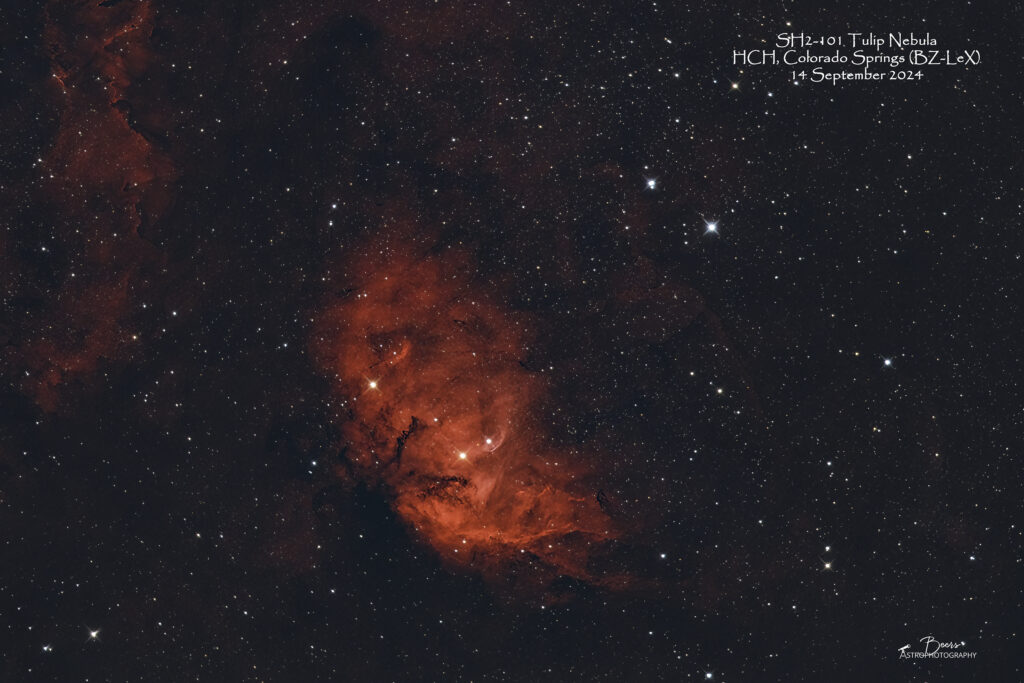We had one more clear night before my crazy work travel schedule will have me away from home until the October New Moon. I decided to take advantage of it to test out the auto-focuser with another telescope-filter configuration. This time it was Big Zeus with the LeXtreme filter (against the 85% Waxing Gibbous that was up most of the night). It was a bit of a rocky start, but in the end, I have finally figured out all the settings needed to get the auto-focuser AND auto-guider to work successfully throughout a sequence!! Not sure if you want to call it persistent or obsessive, but it’s “fixed”!!

One last pesky setting, unchecked…
As background, from my 6 September 2024 imaging of IC5146 Cocoon Nebula… The autoguider decided not to work reliably throughout the night. It would connect fine, conduct the calibration at the beginning of each sequence, pause during auto-focus (while I was watching it), and resume. But it stopped unexpectedly during the sequence – first at about an hour into the sequence from the start that I discovered when I went out at midnight to conduct the meridian flip. Second about two hours into the sequence after the meridian flip. Both times the error message in PHD2 stated “ASCOM driver disconnected, check cabling or driver.” All the cabling was fine and still attached. Originally, I thought it was because the cable was too short and with all the cabling in a bundle, a straining may have pulled on the cabling to cause it to electrically disconnect, causing the autoguider to fail (need to check to make sure that laptop has auto-recovery set up correctly and selected). Then after looking at the timing of the disconnect, I’m beginning to wonder if it had to do with the pause during auto-focus that it couldn’t recover from.
Fast-forward a week and a day to one last clear night before I spend the rest of the month traveling for work… The last “missing piece” of the EAF puzzle fell into place! As I’d suspected, the auto-guider was not coming back to operation from its pause while the autofocus was running. I came out an hour after I’d started the Tulip Nebula sequence to find SGP was in recovery mode, stating “Something terrible has happened and we’re trying to recover.” It was indeed trying to recover from PHD2 having lost its guide stars. At that point I turned off the autofocuser, noting the time, so I could contact SGP support in the morning with the log and point to the time the error occurred. While I laid in bed “sleeping” it occurred to me that I could do an experiment to run the autofocuser while the autoguider was running to see if it would resolve a good focus point. When I went out to switch targets, I opened the M52 Cassiopeia Salt & Pepper Cluster sequence and went into the control panel to make that change in the settings. While I was hovering over the check box, I read the instructions (there I go again…) and it said that function was meant for off-axis guiders (OAG) because when the autofocuser takes the stars too much out of focus, it may lose track. Hmm, I don’t have an OAG, so this may be worth a try! I unchecked the “pause autoguiding during focus” and started the sequence. Low and behold – it worked! I came out at the one-hour point from the start of the beginning of the M52 sequence execution, and it was in the midst of the autofocus routine. The autofocus routine completed successfully, the autoguider conducted its dither, and the sequence started up again on the next subframe collection! So, yet again, it was my settings and not an issue with any of the hardware or software (or their integration) that was causing the problem.
Although this was a “first” with BZ and LeX I didn’t run the SGP step-size experiment. I collected the data during each run of the auto-focuser – to ensure that the step size was producing the correct change in star HFR value – which it was. I used the 150-step size from the BB-LeX experiment on 27Aug2024, using the theory that it’s the filter and not the telescope that matters. In reality it’s probably a mix of both, but since both BB and BZ are f/8.0 apertures, I’m guessing that’s why the same filter is giving the same step-size result across both telescopes. (I’ll have to do the full-up step-size test with the Southern Cross to see if that’s different).
A Nebula and a Star Cluster…
I spent the night on two targets – first the SH2-101 Tulip Nebula, then when it set behind the roof switching to a star cluster, M52 Cassiopeia Salt & Pepper Cluster. I have imaged very few star clusters and figured it was about time to give one of them some love – so the Salt & Pepper it was!
Ironically, these were the two targets I was planning to image on 6 September 2024 when I first encountered the auto-guider / auto-focuser issue…we’ll never know if I would have figured it out on the second target that night or not! The images, fun facts, and capture notes (that will sound very much like the description above) are in the gallery at: https://beersastrophotography.com/gallery/m52-cassiopeia-salt-pepper-cluster/ and https://beersastrophotography.com/gallery/sh2-101-tulip-nebula/
